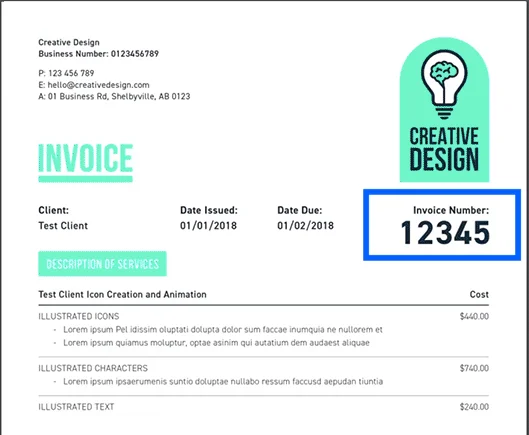When it comes to assigning invoice numbers, life can seem like it is not all that straightforward. This is particularly true if you have multiple clients: do you have a separate invoice numbering system for each client?
Our tips on how to assign invoice numbers will make your life so much easier in terms of keeping track of all of your invoices, no matter how small or large your business. Moreover, if you have a tax audit, proper invoicing is a must: so check out our advice to ensure that you stay above board.
What is an invoice number?
An invoice number is a unique number that is assigned to each invoice. This number is one of the most important elements of every invoice. Its role is to identify transactions, so it needs to be unique. Invoice number can contain only numbers or letters and numbers. It may contain date of issue, name of project or task.

Invoice number on an invoice
zistemo hint #1 If you want to be sure that your invoice will consist of all required elements – issue invoices for FREE with FREE Invoice Generator
Best practices on numbering invoices
- Make every invoice number unique – you can start from any number you want
- Assign sequential invoice numbers
- Assign invoice numbers in chronological way
- Structure invoice numbers any way you want, you may: use only numbers 001, 002, 003 etc., include Customer Name CN001, CN002, etc. or even add Project Name or Number PN-CN-001, PN-CN-002
- Use Invoicing Software to support you in sequential numbering system
Assigning invoice numbers on an invoice with zistemo
What invoice number should I start with?
You can structure your invoice number any way you want, you can start from number 1 or 100, but it is good to follow some rules and best practices to keep invoice numbers in order.
How to number invoices?
The simple solution to this is to just label all invoices sequentially, at least for the same tax year.
- So the first invoice you send out to whatever client, is invoice ‘1’.
- Then, the second invoice you send out, no matter if that is the same client or a different one, gets an invoice numbered ‘2’.
- That way, you never have invoices with duplicate numbers.
zistemo hint #2 If you want to be sure your invoice numbers are assigned correctly, why not start issuing invoices with zistemo?
It’s more than Invoicing Software and it gives you fully customizable invoice numbering. So when you put an initial number 0001301 for instance - zistemo will automatically increment that number.
Invoice numbers templates
Here are some examples of invoice numbers.
An invoice
In most simple words an invoice is a document issued by a seller to a buyer that specifies amount and costs of services or products provided by the seller. To know more check what is an invoice and how to create a good invoice to get paid faster.
Invoice Templates created with zistemo Invoice Software
zistemo will keep an eye on the numbers so you don’t get confused any more. With zistemo you will see at a glance:
- which invoices are paid and unpaid
- how old each invoice is: i.e. how long it has been since you issued the invoice to the client.
The possibility for confusion when marking an invoice can be decreased by labelling all invoices…
Does sequential invoice numbers simplify your life?
It can be tempting to have a separate invoice system for each client, or for each month. So, client 1 starts off with invoice numbered ‘1’, and client 2 starts with an invoice number ‘1’ as well. When a new month starts, you might be tempted to reset the numbers back to ‘1’.
You can see how this can get you into a muddle! Suddenly you have several invoices labelled ‘3’, but all for different clients, or for the same client but for different months. Even if you mark invoices with the client and the month, there is increased possibility for confusion. That’s way sequential invoice numbers make your life easier.
Want to number each project separately?
If you really want to, though, you can opt for a project related numbering system. With such a system, you use a separate invoicing sequence for every project that you are working on.
Example of invoice number on a project invoice generated by zistemo Invoice Software
Each project may have multiple clients, though it is much more common for a single project to be allocated to a single client. With this system, the first invoice for project 1 is numbered ‘1’, and the numbers increase sequentially until the end of the project.
The first invoice for project 2 is also numbered ‘1’, and the numbers for this project also increase sequentially until the end of the project. And so on.
Seems a bit complicated? It might. But don’t worry zistemo is here to help.
zistemo hint #3 zistemo masters the project related numbering and it supports Customer Level Invoice Sequence. The advantage of a project related numbering system is that it helps you to deal with each project as a self-contained unit. Why not sign up for a FREE trial and see for yourself?
This is particularly good for medium sized or larger businesses, which perhaps have separate teams of employees working on each of several projects at a given time.
The project related numbering system nevertheless works on a basic sequential numbering model, so it also has the advantages of sequential numbering systems, as discussed above.
Are you in a risk to fail a tax audit?
We know for sure that:
- Different regulatory requirements in each country significantly increase the cost and complexity of tax compliance.
- Non-compliance to the country-specific electronic invoicing regulations increases business risks associated with a tax audit, and in some cases, fines.
As a result of these challenges, many companies choose to comply via paper invoices and manual processes and miss out on the huge opportunity for cost savings and streamlined processes that can be derived from e-invoicing.
If your accounts are audited, then incorrectly numbered invoices can look suspicious. Moreover, as suggested above, if you have several invoices with duplicate numbers, the margin for error is greatly increased.
This means that you are much more likely to make a mistake in your tax calculations, thinking that you have factored in a certain invoice when in fact you have not. This is another reason why sequential numbering of invoices makes your life easier all round.
zistemo hint #4 “The advantage of a sequential numbering system is that it helps you to deal with each project as a self-contained unit and prevent from mistakes in tax calculation”.
How long do invoices need to be stored for?
Storing invoices for as long as possible is a good idea. Not only does it help you to keep track of how your business’s finances have developed over the years, it also gives you piece of mind.
- Who knows when a client might query an invoice they paid several years ago?
- Who knows when a client that you dealt with a decade ago might pop back up wanting to work with you again?
In these cases, it is a great idea to have their old invoices to hand to see how much they paid you, and also how promptly they paid. If old invoices show that certain clients took over a year to pay, for example, leaving you financially in the lurch, you might be wary of working with them again.
Each country that applies a tax to goods and services needs to manage its own unique regulatory requirements for electronic invoices – e.g. rules for electronic signatures, the number of years electronic invoices must be archived.
Storing Invoices tips from zistemo
- As a guide, though, depending on the country you are trading in, invoices should really be kept from 3 to 10 financial years.
- Throwing them away during this period is not advised.
- For one thing, your finances could be audited, and you will need to show all of your invoices as proof that you calculated your taxes correctly.
A quick word of warning: even if records aren’t needed for tax reasons, you may need them for other reasons. Make sure that you check with your tax professional before tossing important records.
When it comes to storing your invoices, orderliness is key. Do not let them get strewn all over the office floor! A strong, locked box or a filing cabinet labeled ‘invoices’ is a good idea, for instance.
If you have numerous invoices, you can always input them into a digital database. Just make sure that you have someone checking each entry carefully, as there is additional margin for error when paper invoices are digitized by hand.
Having a computerized record of invoices also enables you to keep data on as many invoices as you like, without them taking up shelf in your filing cabinet.
zistemo hint #5 “Number invoices sequentially and keep records of them for 3 to 10 financial years to ensure that everything is in order with your business. That way, you have nothing to fear from potential audits of your finances.”
With us, invoice numbering is painfree!
It’s never too late to organize your invoices. Start right now by joining zistemo for free and see how simple it all becomes.








